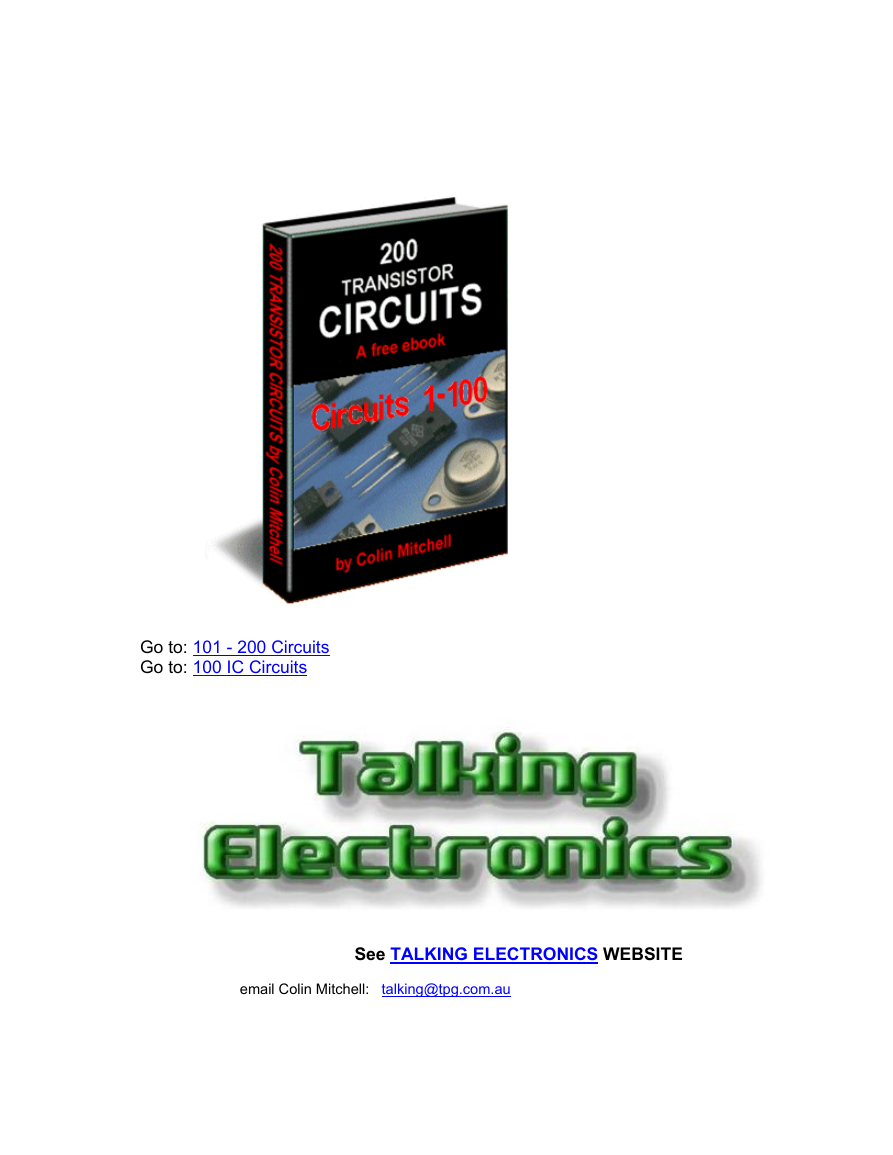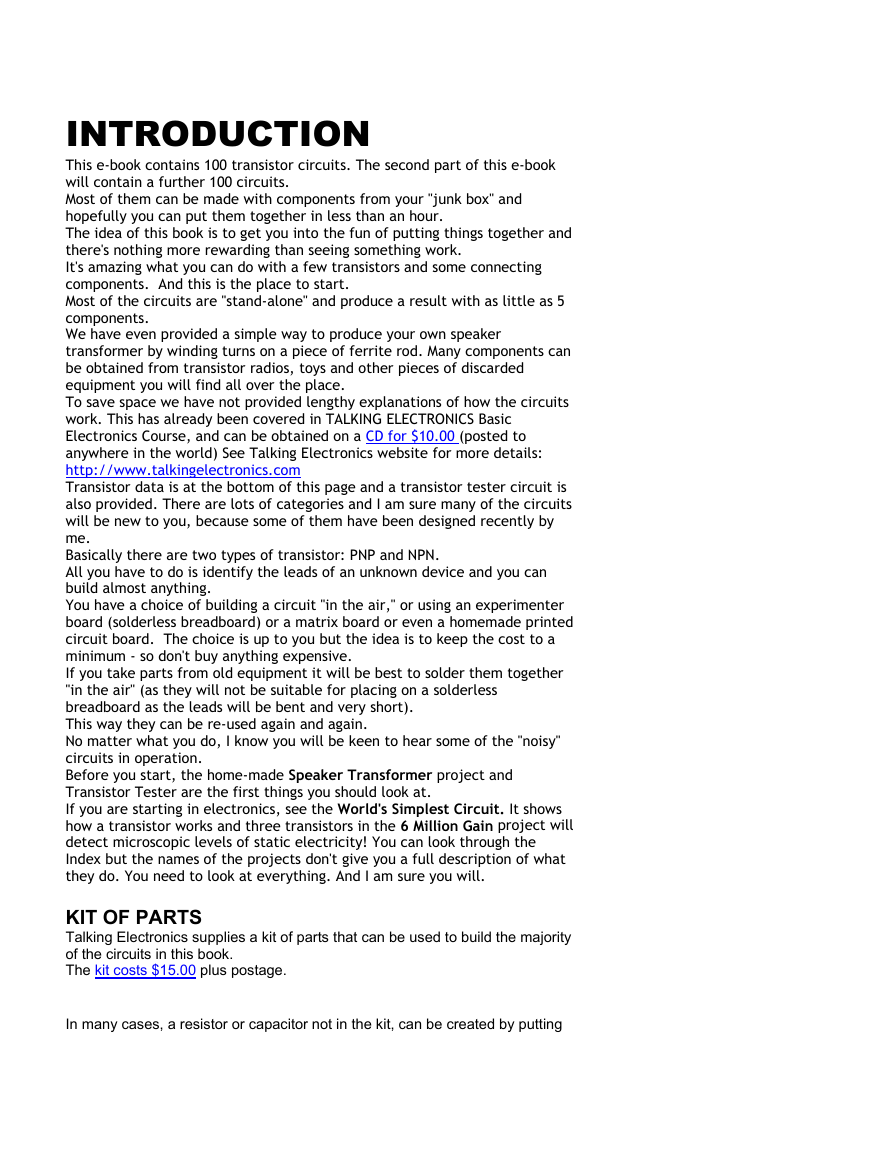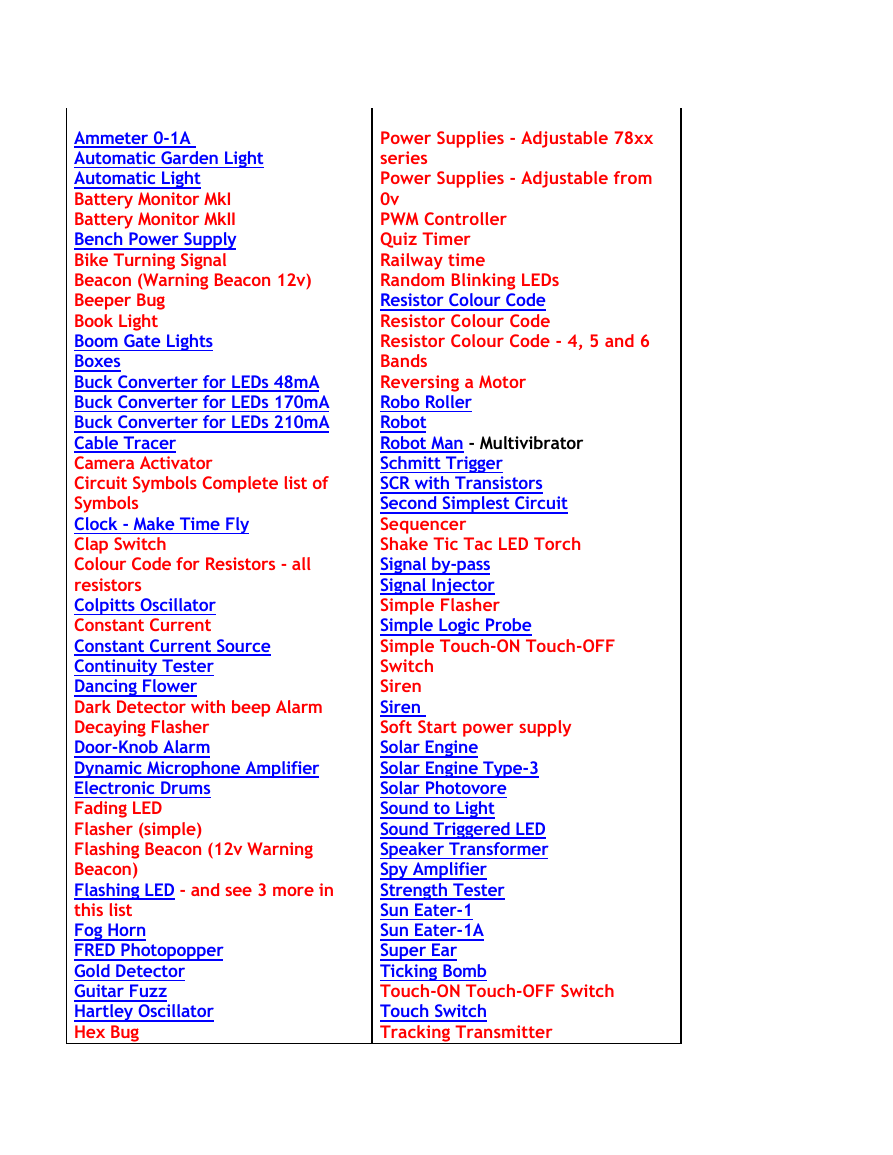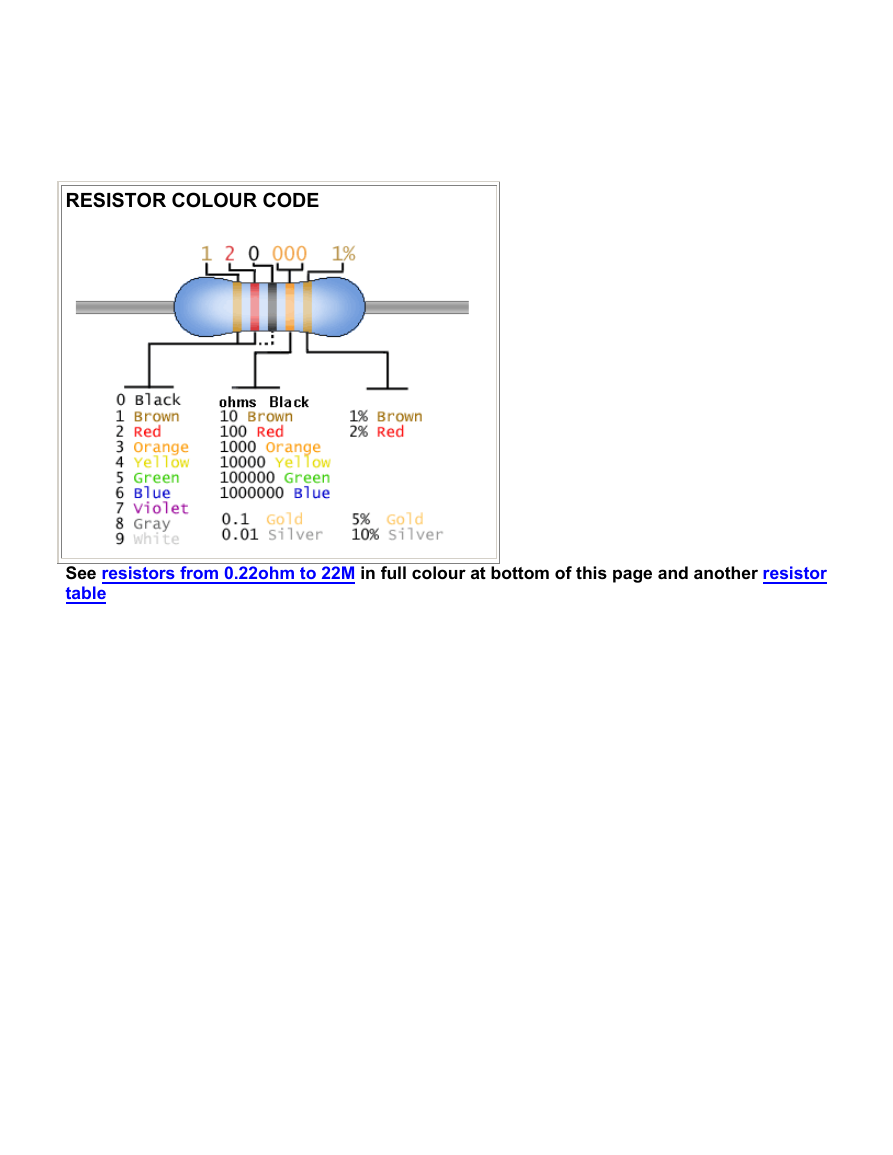Go to: 101 - 200 Circuits
Go to: 100 IC Circuits
See TALKING ELECTRONICS WEBSITE
email Colin Mitchell: talking@tpg.com.au
�
INTRODUCTION
This e-book contains 100 transistor circuits. The second part of this e-book
will contain a further 100 circuits.
Most of them can be made with components from your "junk box" and
hopefully you can put them together in less than an hour.
The idea of this book is to get you into the fun of putting things together and
there's nothing more rewarding than seeing something work.
It's amazing what you can do with a few transistors and some connecting
components. And this is the place to start.
Most of the circuits are "stand-alone" and produce a result with as little as 5
components.
We have even provided a simple way to produce your own speaker
transformer by winding turns on a piece of ferrite rod. Many components can
be obtained from transistor radios, toys and other pieces of discarded
equipment you will find all over the place.
To save space we have not provided lengthy explanations of how the circuits
work. This has already been covered in TALKING ELECTRONICS Basic
Electronics Course, and can be obtained on a CD for $10.00 (posted to
anywhere in the world) See Talking Electronics website for more details:
http://www.talkingelectronics.com
Transistor data is at the bottom of this page and a transistor tester circuit is
also provided. There are lots of categories and I am sure many of the circuits
will be new to you, because some of them have been designed recently by
me.
Basically there are two types of transistor: PNP and NPN.
All you have to do is identify the leads of an unknown device and you can
build almost anything.
You have a choice of building a circuit "in the air," or using an experimenter
board (solderless breadboard) or a matrix board or even a homemade printed
circuit board. The choice is up to you but the idea is to keep the cost to a
minimum - so don't buy anything expensive.
If you take parts from old equipment it will be best to solder them together
"in the air" (as they will not be suitable for placing on a solderless
breadboard as the leads will be bent and very short).
This way they can be re-used again and again.
No matter what you do, I know you will be keen to hear some of the "noisy"
circuits in operation.
Before you start, the home-made Speaker Transformer project and
Transistor Tester are the first things you should look at.
If you are starting in electronics, see the World's Simplest Circuit. It shows
how a transistor works and three transistors in the 6 Million Gain project will
detect microscopic levels of static electricity! You can look through the
Index but the names of the projects don't give you a full description of what
they do. You need to look at everything. And I am sure you will.
KIT OF PARTS
Talking Electronics supplies a kit of parts that can be used to build the majority
of the circuits in this book.
The kit costs $15.00 plus postage.
In many cases, a resistor or capacitor not in the kit, can be created by putting
�
two resistors or capacitors in series or parallel or the next higher or lower value
can be used.
Don't think transistor technology is obsolete. Many complex circuits have one
or more transistors to act as buffers, amplifiers or to connect one block to
another. It is absolutely essential to understand this area of electronics if you
want to carry out design-work or build a simple circuit to carry out a task.
CONTENTS circuits in red are in 101-200 Circuits
�
Ammeter 0-1A
Automatic Garden Light
Automatic Light
Battery Monitor MkI
Battery Monitor MkII
Bench Power Supply
Bike Turning Signal
Beacon (Warning Beacon 12v)
Beeper Bug
Book Light
Boom Gate Lights
Boxes
Buck Converter for LEDs 48mA
Buck Converter for LEDs 170mA
Buck Converter for LEDs 210mA
Cable Tracer
Camera Activator
Circuit Symbols Complete list of
Symbols
Clock - Make Time Fly
Clap Switch
Colour Code for Resistors - all
resistors
Colpitts Oscillator
Constant Current
Constant Current Source
Continuity Tester
Dancing Flower
Dark Detector with beep Alarm
Decaying Flasher
Door-Knob Alarm
Dynamic Microphone Amplifier
Electronic Drums
Fading LED
Flasher (simple)
Flashing Beacon (12v Warning
Beacon)
Flashing LED - and see 3 more in
this list
Fog Horn
FRED Photopopper
Gold Detector
Guitar Fuzz
Hartley Oscillator
Hex Bug
Power Supplies - Adjustable 78xx
series
Power Supplies - Adjustable from
0v
PWM Controller
Quiz Timer
Railway time
Random Blinking LEDs
Resistor Colour Code
Resistor Colour Code
Resistor Colour Code - 4, 5 and 6
Bands
Reversing a Motor
Robo Roller
Robot
Robot Man - Multivibrator
Schmitt Trigger
SCR with Transistors
Second Simplest Circuit
Sequencer
Shake Tic Tac LED Torch
Signal by-pass
Signal Injector
Simple Flasher
Simple Logic Probe
Simple Touch-ON Touch-OFF
Switch
Siren
Siren
Soft Start power supply
Solar Engine
Solar Engine Type-3
Solar Photovore
Sound to Light
Sound Triggered LED
Speaker Transformer
Spy Amplifier
Strength Tester
Sun Eater-1
Sun Eater-1A
Super Ear
Ticking Bomb
Touch-ON Touch-OFF Switch
Touch Switch
Tracking Transmitter
�
H-Bridge
Heads or Tails
Hearing Aid Constant Volume
Hearing Aid Push-Pull Output
Hearing Aid 1.5v Supply
Hee Haw Siren
IC Radio
Increasing the output current
Intercom
Latching Relay
LED Detects Light
LED Detects light
LED Flasher - and see 3 more in this
list
LED Flasher 1-Transistor
LED Torch with Adj Brightness
LED Torch with 1.5v Supply
LED 1-watt
LED 1.5 watt
LED Driver 1.5v White LED
LED flasher 3v White LED
Lie Detector
Light Alarm-1
Light Alarm-2
Light Alarm-3
Light Extender for Cars
Limit Switches
Listener - phone amplifier
Logic Probe - Simple
Logic Probe with Pulse
Low fuel Indicator
Mains Night Light
Make any resistor value
Make Time Fly!
Making 0-1A Ammeter
Metal Detector
Microphone Pre-amplifier
Model Railway time
Motor Speed Controller
Movement Detector
Multimeter - Voltage of Bench
Supply
Music to Colour
On-Off via push Buttons
Phaser Gun
Phone Alert
Track Polarity - model railway
Train Detectors
Train Throttle
Transformerless Power Supply
Transistor Pinouts
Transistor Tester-1
Transistor Tester-2
Trickle Charger 12v
Voltage Multipliers
Wailing Siren
Walkie Talkie
Walkie Talkie with LM386
Walkie Talkie - 5 Tr - circuit 1
Walkie Talkie - 5 Tr- circuit 2
Worlds Simplest Circuit
White LED Flasher
White LED with Adj Brightness
White Line Follower
Zener Diode (making)
0-1A Ammeter
1-watt LED
1.5 watt LED
1.5v to 10v Inverter
1.5v LED Flasher
1.5v White LED Driver
3-Phase Generator
3v White LED flasher
5v from old cells
5 LED Chaser
5 Transistor Radio
5v Regulated Supply from 3v
6 Million Gain
6 to 12 watt Fluoro Inverter
12v Flashing Beacon (Warning
Beacon)
12v Relay on 6v
12v Trickle Charger
20 LEDs on 12v supply
20watt Fluoro Inverter
27MHz Door Phone
27MHz Transmitter
27MHz Transmitter - no Xtal
27MHz Transmitter-Sq Wave
27MHz Transmitter-2 Ch
27MHz Transmitter-4 Ch
27MHz Receiver
�
27MHz Receiver-2
303MHz Transmitter
Phone Tape-1
Phone Tape-2
Phone Tape-3
Phone Transmitter-1
Phone Transmitter-2
Phase-shift Oscillator
Power Supplies - Fixed
Power Supplies - Adjustable LMxx
series
�
RESISTOR COLOUR CODE
See resistors from 0.22ohm to 22M in full colour at bottom of this page and another resistor
table
�
BOXES FOR PROJECTS
One of the most difficult things to find is a box for a project.
Look in your local "junk" shop, $2.00 shop, fishing shop,
and toy shop. And in the medical section, for handy boxes.
It's surprising where you will find an ideal box.
The photo shows a suitable box for a Logic Probe or other
design. It is a toothbrush box. The egg shaped box holds
"Tic Tac" mouth sweeteners and the two worm reduction
twists a "Chuppa Chub." It cost less than $4.00 and the
equivalent reduction in a hobby shop costs up to $16.00!
A two-worm reduction gearbox producing a reduction
of 12:1 and 12:1 = 144:1 The gears are in the correct
positions to produce the reduction.
to Index
ransformer
of
h
The speaker t
is made by winding 50 turns
0.25mm wire on a small lengt
of 10mm dia ferrite rod.
the rod
The size and length of
does not matter - it is just the
number of turns that makes
the transformer work. This is
called the secondary winding.
The primary winding is made by winding 300 turns of 0.01mm wire
(this is very fine wire) over the secondary and ending with a loop of
wire we call the centre tap.
Wind another 300 turns and this completes the transformer.
It does not matter which end of the secondary is connected to the top
of the speaker.
It does not matter which end of the primary is connected to the
collector of the transistor in the circuits in this book.
to Index
�















